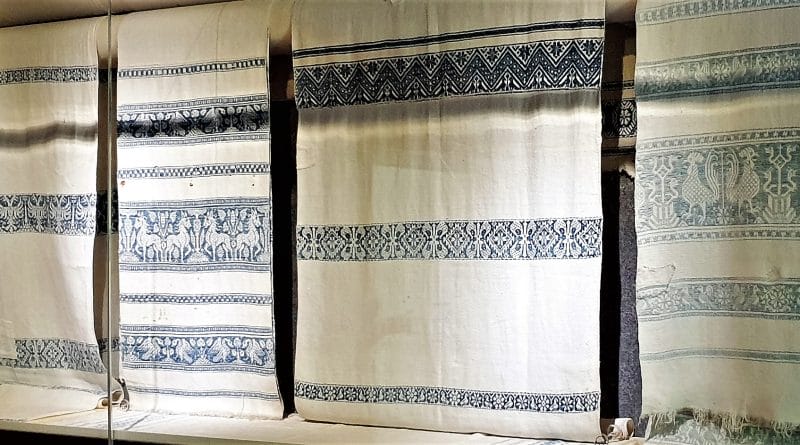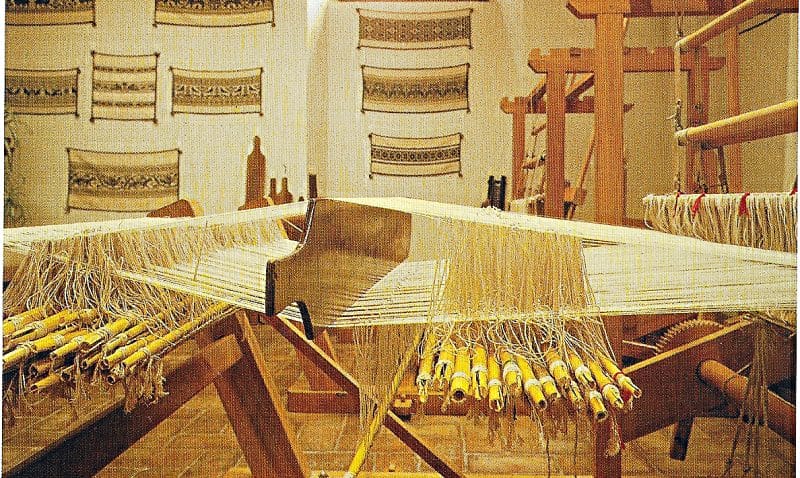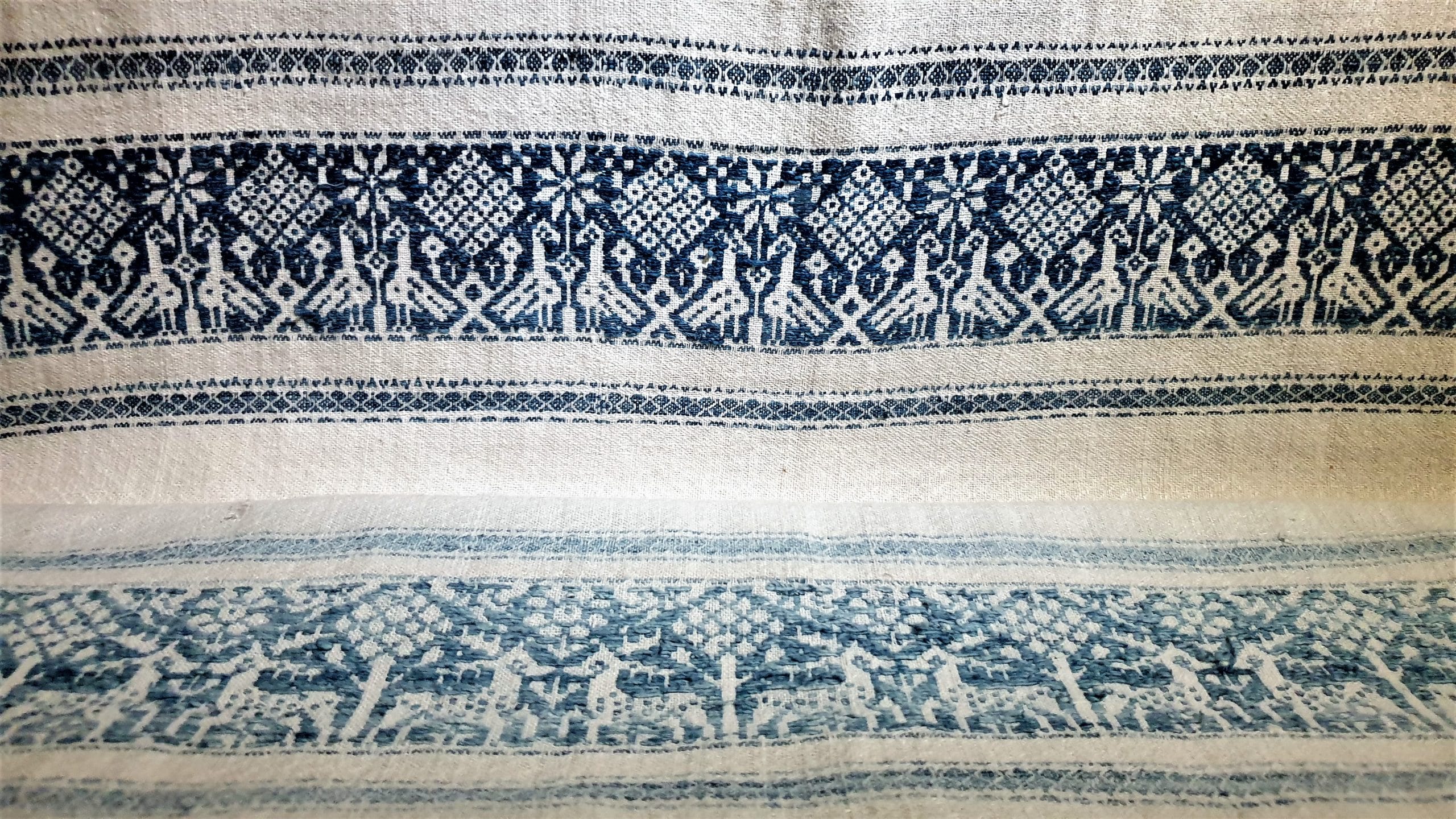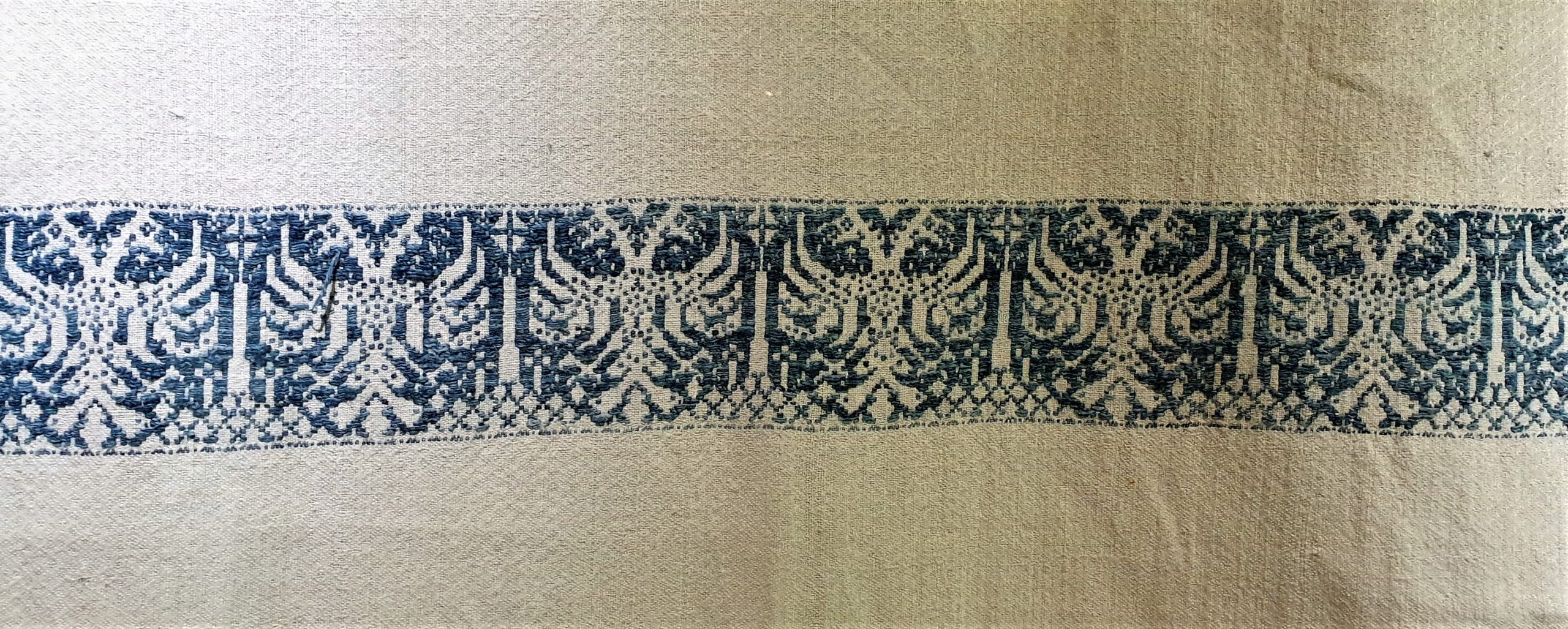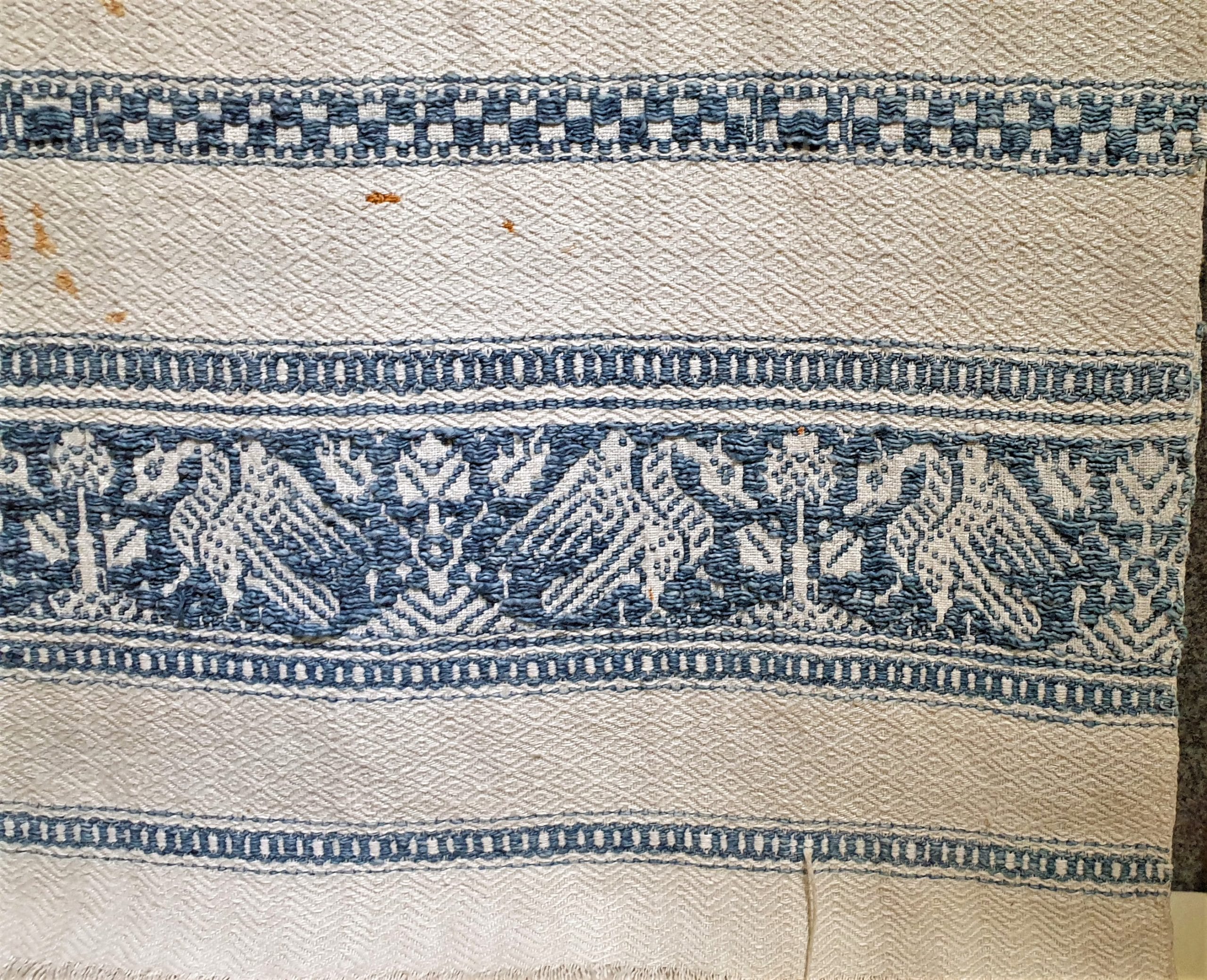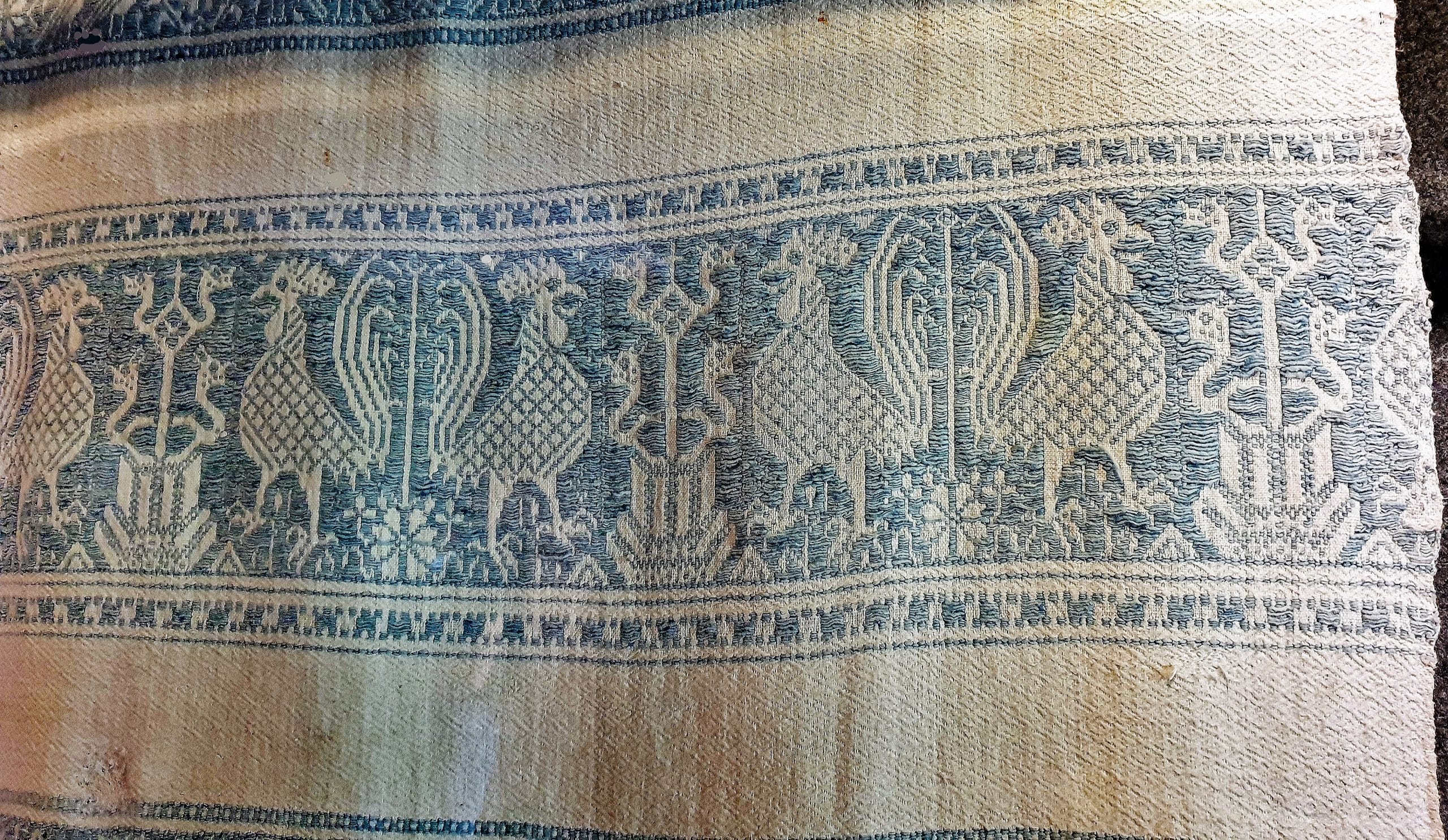UMBRIAN OR FRIULIAN ANCIENT TEXTILES?
Translation by Chiara Cordoni
In Friuli, in the Alpine region of Carnia, the small Museum of the Pieve di Gorto in Cella, a fraction of the Municipality of Ovaro (Udine), retains an interesting collection of sacred vestments and six cloths for the Holy Table exhibited together with a manutergium (liturgic towel, similar to tablecloth for technique and color )[1], these date back from the 15th to the 19th century. They are long and narrow linens, in natural white, adorned with small motifs woven in diamond and zigzag patterns (bird’s eye, button-like, herringbone), decorated on the two short sides by horizontal patterns of symbolic designs, zoomorphic (peacocks, doves, roosters, deer), vegetal (vine leaves, trees), geometric (checkered, triangles) – from time to time you can come across stars, crosses, source of life, towered walls, inscriptions. On a white background “endless processions” stand out, made of figures woven in blue linen and cotton dyed with indigo and woad[2]. Who has woven these artifacts and on what type of loom? Exactly what era are they from? How where the drawings taken from the repertoire of Oriental and Christian symbology handed down and reproduced? Among the most represented symbols: the peacock (immortality), the unicorn (virginity), the rooster (emblem of Christ as the eagle and the lamb), the tree and the fountain (continuity of life), etc…. Undoubtedly these productions, reproduced almost identical from the Middle Ages to the nineteenth century, arouse particular interest for the charm and mystery surrounding them and for the richness of the messages contained in the drawings: a language with cultural roots far away in time and space.
[1] Maria Beatrice Bertone, Il museo della pieve di Gorto, guide to the exhibition, 2015, Fagagna (Udine)
[2] A dyeing plant native to Central Asia, introduced in Europe in protohistoric times, cultivated in the Roman age and in the Middle age also in Friuli, later the production decreased due to indigo import from the Orient, but in the Napoleonic era it had a significant growth. .
Matelica, L’ARTELAIO Weaving Laboratory, detail of the LICCETTI, programmed for the weaving of the figures
It is a genre which goes by the name of Umbrian or Perugia fabrics[3], even if it is believed that they may also have been produced in Friuli, where as many as seventy specimens have been collected and catalogued[4]. In the past, these examples of top-class craftsmanship, status symbols since the Middle Ages of which there is no documentation, probably conventual pieces, were not only intended to cover the altar, but were also present in the trousseaus of brides and in the homes of the Lords who made a both sacred and profane use of them. The liturgical and social importance of these artefacts is also testified by their presence in masterpieces of painting, wooden sculptures and frescoes with Christian religious themes[5].
The origins of this particular technique, still present in Italy in the Marches, at the L’Artelaio lab of the Piersanti Museum in Matelica (Macerata), are probably to be found in the Labs of Norman Sicily, where since the 11th century Saracen, Arab and Jewish master weavers practiced refined techniques to reproduce the emblematic figures that we also find in the fabulous patterned silks of Lucca in the 13th century.
[3] Carmen Romeo, Tessuti d’altare in Friuli, aspetti tecnici ed iconografici, in Vultus Ecclesiae, Showcases from the “Museo Diocesan e Galariis dal Tiepolo” in Udin, Udine, 2005. The name Umbrian or Perugia derives from the Region Umbria, and from its chief town, Perugia, where at the beginning of the 20th century this type of fabric was studied and collected in large quantities for the first time, thanks mainly to the contribution of Mariano Rocchi (1855-1943).
[4] In particular, the issue has been studied in depth by Maria Lunazzi Mansi.
[5] Giotto, Il Presepe di Greggio, 1296-1300, Assisi, Basilica Superiore of San Francesco; Domenico Ghirlandaio, 1448, Ultima Cena, Firenze, Museum of San Marco.
In Carnia, Don Marino Pajani (1925-2013), parish priest of Enemonzo (Udine), recounted that until the 1950s the liturgy involved the use of three linen altar cloths, with the forms prescribed and arranged one on top of the other. First of all, the stone in which a relic was incorporated was laid on the Holy Table, then, in contact with the stone, the ancient strip of linen with blue designs was placed and then, one on the other, two other tablecloths. In Cella of Ovaro, the link with the traditions, the beauty of the territory and the presence of such important historical heritage can be appreciated and understood also thanks to the contribution of volunteers such as Mara Cattarinussi and Dino Spangaro who with generosity, passion and competence accompany visitors in the discovery of the local heritage.
